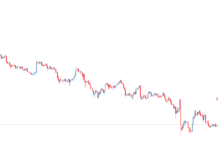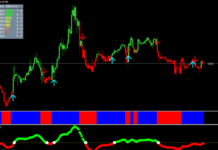RVI indicator (Relative Vigor Index) is an oscillator that shows the energy of the current price movement and reflects the confidence of the price movement from the opening price to the closing one in the range of the maximum and minimum prices of the price period. This provides the trader with the idea of further movement continuation with a greater or lesser probability.
Before reading the article and writing your questions in the comments section, I recommend to watch this video. It’s not long but covers the biggest part of questions on the topic.
I was introduced to the traders’ community by John Ehlers in Stocks&Commodities magazine in January 2002. The RVI indicator is displayed in a new area of the chart’s window of an analyzed asset in two consecutively intersecting lines form – RVI land signal lines, which give trading signals by their intersection.

Logic and detailed description of RVI indicator
RVI indicator is calculated in several steps. First, it’s necessary to calculate the difference between the closing price and the opening price of the period and divide the figure obtained on the difference between the period’s maximum and minimum. If the candle was falling, the quotient would be a negative value, if growing – would be a positive one. Moreover, the quotient value takes relative values while showing how much is the range from opening to closing (the maximum value is -1 and 1 – when the candle opens at one extreme and closes on the opposite) of the total candle’s range (from the minimum to the maximum).
Formula can be written in the following form:
RVI = (Closing-Opening)/(Max-Mini), where Closing is the closing price, Opening is the opening price, Max is the maximum price, Min is the minimum price.
The second step is to smooth RVI value with the moving average (in the basic version, the smoothing occurs over 10 periods), thereby obtaining the RVI line (red indicator line).
The third step is to get the signal, slow RVI line, which is accomplished by a smoothing RVI line with a weighted moving average in four periods (usually shown in a green dashed line, which is smoother than RVI line).
Thus, the RVI indicator shows the consistency of the short-term and long-term consensus of the masses regarding the market unanimity degree regarding the current trend. If the price opens at one extreme and closes on the opposite (RVI = 1), then the movement will continue rather than change. And vice versa – further movement fate is unpredicted if the price has wide fluctuations range from minimum to maximum but opens and closes in the middle of its range.
RVI indicator’s trading signals
The Relative Vigor Index, in contradistinction to classical oscillators, does not have overbought and oversold zones but provides trading signals to making trends by crossing RVI and signal line. If I line (red, faster) crosses the signal (green, smoother) top-down, a purchase is made with a stop order placed behind the last extremum at the opening of the next candle. The position is held until the opposite intersection of RVI and signal line, where the current position with profit-taking fixation is closed and the opposite is opened in a mirror-like manner.

RVI can take both positive and negative values. Therefore, it is believed the market is more inclined to sales if both indicator’s lines are above zero and RVI line is above the signal one, the market is more inclined to purchases than to sales, and if both indicator’s lines are below zero mark and RVI line is under the signal one.

RVI indicator gives the most powerful signal at divergence with the price. So, if the price during the trend updates it’s extreme, which does not happen on the indicator, the trend is ready for a reversal since it is not supported by professional money and continues to move by inertia. In this case, they make a trade at the opening of the next candle after crossing the lines of RVI and signal line with the stop order at the price extremum.

Conclusion
RVI indicator is an oscillator which resembles the MACD indicator by its signals nature. RVI indicator is the link between the indicator and candle analyzes.
A long candle which is opened at a minimum and closed at a maximum – “Maribosa” – is a trend continuation (start) formation, and RVI will have a value of 1 (which will also talk about the trend) at that time in candlestick analysis. At the same time, the “Doji” is a form of uncertainty in candlestick analysis (when opening and closing occur at the same level in the middle of the minimum-maximum range), which will also have corresponding low on RVI values. RVI is best used in conjunction with the trend indicators like all other oscillators.






As always your content and full of very important information and easy to understand. Thanks for sharing.
thnx,I’ll try it….excellent !
Thanks for the many hours you have invested in this, thank you
which time frame is best to use these indicators? Thanks
Can this be applied just to any currency or stock?
This is by far the clearest and most satisfying video i have watched while learning about forex. Thank you.
One of the best and most straightforward technical indicators presentation I have seen! Thank you very much for sharing this with us. I have one question if you don’t mind me asking. In your opinion, do you think RVI is more effective and accurate than Stochastic or using either of the two would be fine?
From experience, all of those indicators are crap. It’s still a 50/50, and it seems like it’s even worse odds when you go live. I’ve studied every single indicator in the Ninjatrader platform, which includes all of these. I have done multiple tests with multiple time frames, multiple settings, etc, using every single instrument. I did this for a couple of years. NONE of these indicators work! I’m telling you,